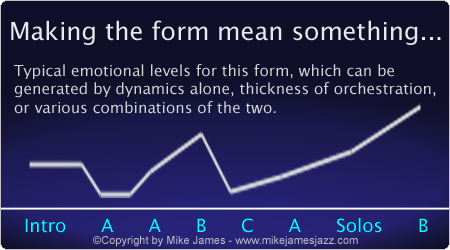Music form for the working musician
When we talk about "form", what we're describing is how the different sections in a song are assembled. For simplicity, we can narrow this down to four words... "Intro", "Verse", "Chorus", and "Bridge". The "Bridge" (or you might use the word "interlude") is an optional section that leads back to the beginning of the song, from the chorus, and doesn't appear in every song. This is probably the most widely-used form in music history. Think of the classic ballad "Misty". It looks like the example below.
The symbols near each end of the graphic are "repeat" signs... Repeat what's between them.

The most widely-used form in music
Of course, creative writers can add as many other sections as they like, or abandon form altogether and write "freeform" music. But for our purposes, the form above is a great example. Many people refer to this as the "AABA" form. (with "A" being the verse "B" being the chorus) You could use "C" for the "Bridge" or "Interlude", and "D" for yet other sections. Most tunes don't get that deep, form-wise. That makes our shorthand labeling method easier, when we get to that later. Note that when you repeat this form, you would play three verses in a row. (one at the end of the form, and two at the beginning)
Once you know how to visualize these forms, it will help you a lot, when you start writing parts for a rehearsal. Listen to the song a couple of times before you start writing, and you may find that you can simply write repeat signs, rather than rewriting each section over and over. Of course, knowing these classic forms will also help you get through a tune you've never heard before. At the very least, knowing the forms will help you make an educated guess as to what to expect next.
Here's a little more detail on how the AABA form is typically arranged. If you've been playing for a while, you'll recognize it as being an extremely typical form.
 A - Intro (typically the same as the last 4 to 8 bars of the chorus)
A - Intro (typically the same as the last 4 to 8 bars of the chorus)- A - Verse (focusing on the melody)
- A - Verse (adding some harmony and/or reinforcing parts) The first and second verses will typically have a slightly different harmony in the last couple of bars, one leading back to another verse, and one leading to the chorus
- B - Chorus (usually a dynamic step up, to add excitement and "brand" the tune)
- C - (Optional "Bridge" or "Interlude") In pop music, this is often some sort of "breakdown".
- A - Verse (usually a reiteration of the second verse, with harmony, etc..
- AABA - Solos here, over the form, or a "D" section
- B - Chorus (Often treated as the song's climax, and played strongly)
- B2 - Chorus Tags (or "Outro", or fade)
Variations:
If you have time, listen to the recording you're learning a couple of times before you start writing. You may realize that you can simply write a couple of repeat signs, rather than re-writing a whole section.
In jazz and classical music, a recapitulation, or "recap" of the song is often stated at the end. So, the form becomes:
AABA - (C secton, solos, etc.) then typically, AB, followed by the ending.
So... Every song (unless it's really strange) has a form of some sort. When you recognize how similar most song forms are, especially in pop music, your job of learning a song and/or writing a part will become a lot easier.